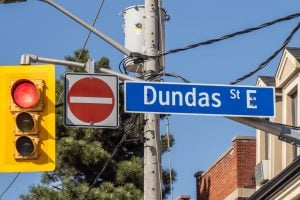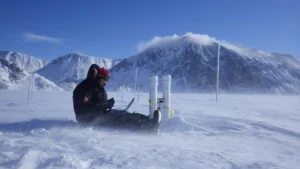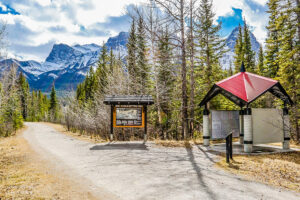
People & Culture
Renaming places: how Canada is reexamining the map
The history behind the Dundas name change and how Canadians are reckoning with place name changes across the country — from streets to provinces
- 4574 words
- 19 minutes
Science & Tech
The last megathrust earthquake to strike Canada was in 1700, and the clock is ticking. How we’re preparing for the impact.

Kate Moran sleeps with a pair of shoes and a flashlight by her bed in Victoria.
The president and chief executive officer of Ocean Networks Canada, an organization that operates two undersea cabled observatories off the coast of Vancouver Island, does this because odds are decent that what’s coming will happen at night, and she doesn’t want to cut her feet on broken glass when she has to get up and out of her house.
Lucinda Leonard, a professor in the school of Earth and ocean sciences at the University of Victoria, got laser eye surgery several years ago, partly because she was worried about how her contact lenses would fare in an emergency and that she wouldn’t be able to reach her glasses.
Alison Bird, an earthquake seismologist with Natural Resources Canada who lives near Victoria, has a strong-motion sensor in her basement; it was installed as part of a larger network of sensors after the area in which she lives was determined to be a “weakly instrumented neighbourhood.”
Carlos Ventura has not yet installed an early-warning sensor in his backyard near the University of British Columbia, where he directs the school’s Earthquake Engineering Research Facility, but he has put in a seismometer at his son’s house in Tofino, on Vancouver Island, to measure the intensity of ground shaking during an earthquake. John Cassidy, meanwhile, knows where to “drop, cover and hold” in every room in his Victoria house and has a DIY earthquake kit that includes enough dog food to keep Winston, his English setter, in good shape for a week in the aftermath of the Big One; such is life as the head of earthquake seismology for the Geological Survey of Canada.
Say what you will about those obsessed with earthquake emergency preparedness, but Moran, Leonard, Bird, Ventura and Cassidy aren’t your garden-variety “preppers.” Rather, they’re among the foremost earthquake experts in Canada, and they and their peers are working to better understand the seismic landscape at home and abroad to prepare for a potentially catastrophic event that could strike at any moment.

The Geological Survey of Canada records and locates more than 4,000 earthquakes each year, an average of about 11 per day. They occur across the country, but most are smaller than magnitude 3 and are not felt. Chances are good, however, that if you live in southwestern British Columbia or southeastern Canada, you’ve experienced a tremor. That’s because these regions, which are home to about 40 per cent of the nation’s population, are two of the most seismically active zones in the country and have been the sites of most of the significant Canadian earthquakes (greater than a magnitude of 5) of the last 300 years.
According to a 2013 study commissioned by the Insurance Board of Canada, there’s at least a five to 15 per cent chance that a “strong earthquake” will hit in the next 50 years in the region from the St. Lawrence River Valley to the Ottawa Valley, an area that includes Quebec City, Montreal and Ottawa. In southwestern British Columbia, the study notes, the likelihood is even higher, with at least a 30 per cent chance of an earthquake strong enough to cause “significant damage” striking in the next 50 years. The financial cost in each scenario could be huge — $60.6 billion in the southern Quebec-southeastern Ontario region, and $74.7 billion in southwestern British Columbia, the IBC report estimates — but so too could the human toll. On the West Coast, for instance, emergency planners in Washington estimate that the death toll in Canada and the United States could exceed 10,000, with three times that number injured.
“If you really look at the risk, it’s low probability but it has extraordinarily high consequences,” says John Clague, a professor in the department of Earth sciences at Simon Fraser University in Burnaby, B.C., and Canada Research Chair in Natural Hazards Research. “It doesn’t happen often, but when it does, it’s catastrophic. Hardening our infrastructure, retrofitting suspect buildings and ensuring that the really critical elements such as bridges and airports will function in the event of an earthquake is expensive, but you can’t prioritize what to spend money on until you fully understand the hazard.”
Doing so in a country as large as Canada is a huge task, and some of the most important work takes place at a complex of labs and offices in Sidney, B.C., on Vancouver Island. This is the home of the western division of Earthquakes Canada, which is part of the Geological Survey of Canada. The Sidney facility and its eastern division in Ottawa monitor information from the 168 Canadian National Seismograph Network stations scattered from St. John’s in the east to Eureka, Nunavut, in the north to Haida Gwaii, B.C., in the west. It’s also where many of Canada’s top earthquake scientists and researchers work.
It was in part due to work done at the Sidney office that something called the Cascadia subduction zone was recognized as the sleeping tectonic monster it is. The zone, which stretches 1,000 kilometres from the northern end of Vancouver Island to Cape Mendocino in northern California, marks the point where one massive slab of the Earth’s crust, the oceanic Juan de Fuca plate, is descending, or subducting, beneath another, the continental North American plate. Subduction produces three kinds of earthquakes: those within the subducting plate (typically at a depth of 30 to 60 kilometres); those within the North American plate (at a depth of up to 30 kilometres); and something called a megathrust earthquake, the world’s largest type of earthquake (at depths shallower than 30 kilometres).
The earthquake and ensuing tsunami that killed 20,896 people and knocked out the Fukushima Daiichi nuclear power station in Japan in 2011, for instance, was a megathrust earthquake, as was the Sumatra earthquake on Dec. 26, 2004, which killed 227,898 people. In the lead-up to a megathrust earthquake, the tectonic plates move toward one another continually, but can get stuck when in contact, creating over long periods of time an immense build-up of strain that eventually exceeds the friction between them; when that point is reached, an earthquake occurs.
As far as scientists have been able to identify, the Cascadia subduction zone has experienced 13 megathrust earthquakes in the last 6,000 years, but they do not happen like clockwork. Indeed, they have come as close together as 200 years and as far apart as 800 years. Randy Enkin, who runs the paleomagnetism and petrophysics laboratory at the Sidney facility, believes the window can be narrowed even further. “According to our offshore work, these earthquakes come every 460 plus or minus 140 years,” he says, as he uses a multi-sensor core logger machine to examine a core sample brought up from the ocean floor off the west coast of Vancouver Island.
“Here we go,” Enkin says. “That is the result of an earthquake. That’s our gold.” It doesn’t look like much, but the anomalous band of rock and chunks of wood debris that interrupt the core’s muted brown tells a violent story: thousands of years ago, a megathrust earthquake rumbled through Vancouver Island, triggering a landslide, the debris fingerprint of which had been captured in the core sample. “We get to solve problems that are really important to society,” Enkin says, gesturing to the digital readouts. “The National Building Code of Canada uses this information to determine the probability of ground shaking, which then goes to engineers who say, ‘This is how we need to build our buildings.’”
“The goals of our research are to ultimately understand how the ground will shake during future earthquakes in Canada, and how often that shaking occurs,” says John Cassidy, who also works out of the centre.
The hope is that by building knowledge of the earthquake cycle — the period of time just before, during and just after an earthquake, as well as the time between earthquakes — and better understanding the seismic past, Cassidy and his colleagues can understand where the most significant shaking occurs and help pre-empt the worst of the damage.
The challenge is that, like the tectonic plates it studies, earthquake science never keeps still. Each new major quake builds on past research. Scientists didn’t anticipate the size of the 2011 Japan earthquake because they didn’t believe the region was able to produce anything stronger than a magnitude 8 (about 32 times less powerful than the magnitude 9 the earthquake was eventually determined to be). The magnitude 6.3 earthquake that struck Christchurch, New Zealand, in 2011 was a similar surprise; scientists didn’t even know there was a fault in the region until a much less damaging magnitude 7.1 earthquake occurred in September 2010. (The 2011 tremor was so destructive because it occurred at a depth of about four kilometres and about 10 kilometres outside Christchurch, whereas the 2010 quake happened at a depth of about 10 kilometres and about 40 kilometres outside the city). Then, in 2012, Haida Gwaii experienced a subduction zone earthquake in an area where scientists had suspected such an event was possible but previously had no evidence for it.
The good news is that each new earthquake that’s studied helps fill in the picture of what to expect in Canada, whether it’s in the Charlevoix seismic zone (the most seismically active region in southeastern Canada, about 100 kilometres downriver from Quebec City), in the Arctic (in places such as Baffin Island and the Boothia and Ungava peninsulas, areas where seismic activity may be caused by the ground slowly rising thousands of years after the glaciers that once covered it melted, a movement known as postglacial rebound) or on Vancouver Island. For the latter, observations on how the surface of the island is currently bulging up two millimetres per year on its western edge informs models of where the North American plate and Juan de Fuca plate are locked and storing the greatest amount of energy. That first view of the Pacific Ocean that greets you when you drive across the island on Highway 4?
Thanks to a small army of GPS stations on the island, scientists now know that’s the eastern edge of the potential rupture zone for a megathrust earthquake. It begins near the coast and extends 100 kilometres offshore. If you get out of your car to take in the view, 35 kilometres beneath you is where the two plates are stuck on each other, building up strain, waiting for something to give.

When a fault such as the Cascadia subduction zone does finally rupture, triggering a massive earthquake, it may be possible to get a 10- to 90-second warning before the serious shaking starts, depending on your location. It’s a small window of time, but it could allow infrastructure operators and utility providers to be warned. This is what happens in Japan, where information from a vast network of sensors is used to stop the country’s famed bullet trains in the seconds preceding an earthquake’s damaging seismic waves.
Ocean Networks Canada is currently prototyping a similar system by installing a dozen hypersensitive motion sensors across and offshore northern Vancouver Island; these will allow for a rapid detection and reporting of spreading seismic waves before they reach Vancouver and Victoria. The potential applications are myriad: airports could stop planes from taking off or landing; gas companies could turn off the supply at the flick of a switch; and bridge entrance lights could turn red. “The concept is to prevent the secondary impacts of the earthquake, which are really more damaging than the primary shaking itself,” says Benoît Pirenne, the director of user engagement at Ocean Networks Canada.
A similar early-warning system run by the Earthquake Engineering Research Facility at the University of British Columbia is currently in operation in B.C. schools. Apart from getting a short-notice warning about imminent tremors, however, most schools simply need to be made more earthquake resistant. To that end, British Columbia has undertaken a massive seismic retrofit of its public schools, using guidelines purpose-built to optimize lifesaving bang for public-taxpayer’s buck. “We developed state-of-the-art guidelines that make use of the latest information about earthquake engineering based on lessons learned from earthquakes around the world,” says Carlos Ventura. More than 200 schools have already been seismically retrofit using the new guidelines.
Raymond Afan is the Vancouver School Board’s project manager for seismic upgrades. “Every time we finish a structural upgrade, I always go, ‘Whew, that’s one off the list. What’s next?’ ” he says. “Because when I hear stories about Haiti or Japan or New Zealand suffering a catastrophic earthquake, I can’t help but think, ‘Jeez, we’re sitting on a fault here.’ ”
Related: Canada’s biggest earthquakes

Thanks to the rich oral histories of First Nations on Vancouver Island, historical records in Japan and paleoseismologists, it’s possible to picture what must have been a terrifying event.
It’s not known precisely where this occurred, but when the deadlock between the plates finally broke, it triggered a rupture that spread at two to four kilometres per second along the zone’s 1,000-kilometre length. As the strained rock of the North American plate reached its breaking point and heaved past the subducting Juan de Fuca Plate, parts of the West Coast of North America leapt up to 10 metres west in a matter of seconds. Oral reports describe shaking so strong that people were unable to stand, and so prolonged that it made them sick. At Kwakiutl, near today’s Port Hardy, houses built of heavy timbers collapsed and landslides buried an entire Cowichan village.
Then there was the tsunami. The two plates clashed off Vancouver Island, deep under the sea floor. When the fault ruptured, the North American plate not only jumped west but also upsurged at this collision point, raising a wall of water that radiated across the Pacific. By the time it reached Japan some nine hours later, the wave was up to 3.6 metres high, and destroyed ships, washed away buildings and flooded rice paddies. When it struck the First Nations villages along Vancouver Island’s west coast, however, it was between 12 and 15 metres high. In Barkley Sound, near Port Alberni, a stampede of fleeing tiny animals is said to have augured danger to the sleeping Hupacasath villagers, who followed them uphill to safety. Others were not so lucky. The entire village of Anacla, on Pachena Bay, just south of Bamfield, was washed away, leaving no survivors.
“We were part of the 1700 tsunami story,” says Tom Mexsis Happynook, a councillor with the Huu-ay-aht First Nation, the group to which the Anacla villagers belonged. Today, Pachena Bay is once more home to the Huu-ay-aht people, and they are better prepared for a repeat of the 1700 quake. “We’re very susceptible to a huge wave coming back into Pachena Bay,” says Happynook, “but we’ve built our Big House up on the hill across the river and we’re in the process of building a subdivision there, too.” The community’s daycare centre often runs drills with the kids, who get 15 minutes to race to high ground.
The 1700 quake was 319 years ago, a number that’s five years away from being within Randy Enkin’s window of megathrust earthquake recurrence. “Buildings designed to modern building codes should not collapse during a major earthquake,” says John Cassidy, the Geological Survey of Canada earthquake seismologist with dog food in his DIY earthquake kit. “And if people feel shaking and know what to do — for example, get under a table or a desk and hold on — then it’s all very survivable. We’re not afraid of the earthquake, but we are prepared for the earthquake.”
According to the GPS units on the island that measure the buildup of stress in the Earth’s crust, the earthquake cycle that Cassidy, his colleagues in Sidney and others elsewhere study could be nearing its end. Does that mean the Big One is about to hit? It’s impossible to say. But what’s certain is that it’s not a question of if, but when. “Right now, the fault is essentially getting springloaded,” says Lucinda Leonard, the University of Victoria professor who had laser eye surgery in preparation for a forthcoming earthquake. “It’s ready to fire.”
Are you passionate about Canadian geography?
You can support Canadian Geographic in 3 ways:

People & Culture
The history behind the Dundas name change and how Canadians are reckoning with place name changes across the country — from streets to provinces

Science & Tech
Celebrating Canadian Innovation Week 2023 by spotlighting the people and organizations designing a better future

Travel
The trail started with a vision to link Canada coast to coast to coast. Now fully connected, it’s charting an ambitious course for the future.

Wildlife
Canada jays thrive in the cold. The life’s work of one biologist gives us clues as to how they’ll fare in a hotter world.